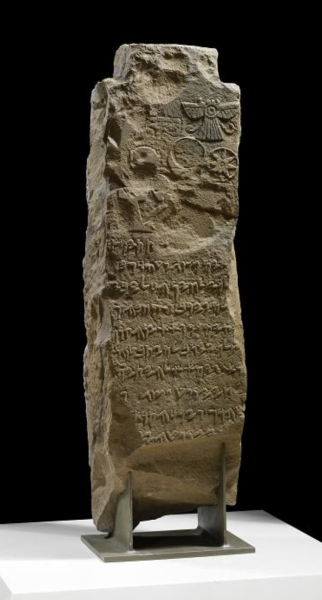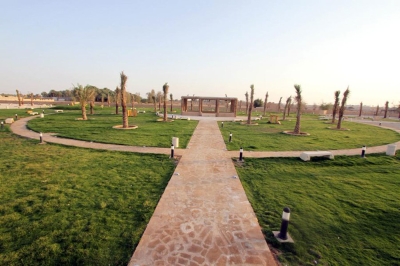

The Ancient Sandstone Stele from Tayma is a stele made of sandstone, discovered in al-Hamra Palace, located in Tayma Governorate, Tabuk Province, north of the Kingdom of Saudi Arabia. The stele dates back to the period between 555 BCE and 539 BCE. It is rectangular in shape, with a sculpted horizontal bar at the top and a roughly carved, irregular base at the bottom. Its surface is divided into two sections. The upper section contains symbolic carvings, including a winged sun disk on the left, an unclear shape to its right, a star enclosed within a circle with a central circular hole on the lower left, a carved bull with upright horns curved inward, and a prominent human figure in front of the bull with its left hand raised upward. The lower section features an Aramaic inscription consisting of ten vertically aligned lines extending horizontally.
The stele was discovered as part of archaeological surveys and excavations conducted by the Antiquities and Museums Sector Saudi Arabia over the past years. It is also among the findings of Saudi archaeologists, scientific missions, and joint research teams.
History of the stele
The sandstone stele represents the Tayma civilization during the Babylonian period. Tayma is renowned for its wealth of archaeological discoveries, having been a significant settlement since ancient times and a crucial geographic point of connection. The stele served commemorative purposes.
The stele is registered under number 1020 and is preserved in the National Museum in Riyadh City. It was selected to be exhibited alongside a diverse collection of Saudi archaeological discoveries in the Saudi Archeological Masterpieces Through the Ages Exhibition.
Dimensions of the stele
Height: 102 cm.
Width: Forty-five cm.
Thickness: Sixteen cm.
Significance of the stele
This stele is distinguished by a collection of carved symbols that adorn its surface. The style of inscription and decoration closely resembles symbols from other civilizations that thrived in various regions, including the Babylonian civilization, the Sumerian culture between the Tigris and Euphrates rivers, and the Egyptian civilization, which flourished along the banks of the Nile.
Related quizzes
Related articles
